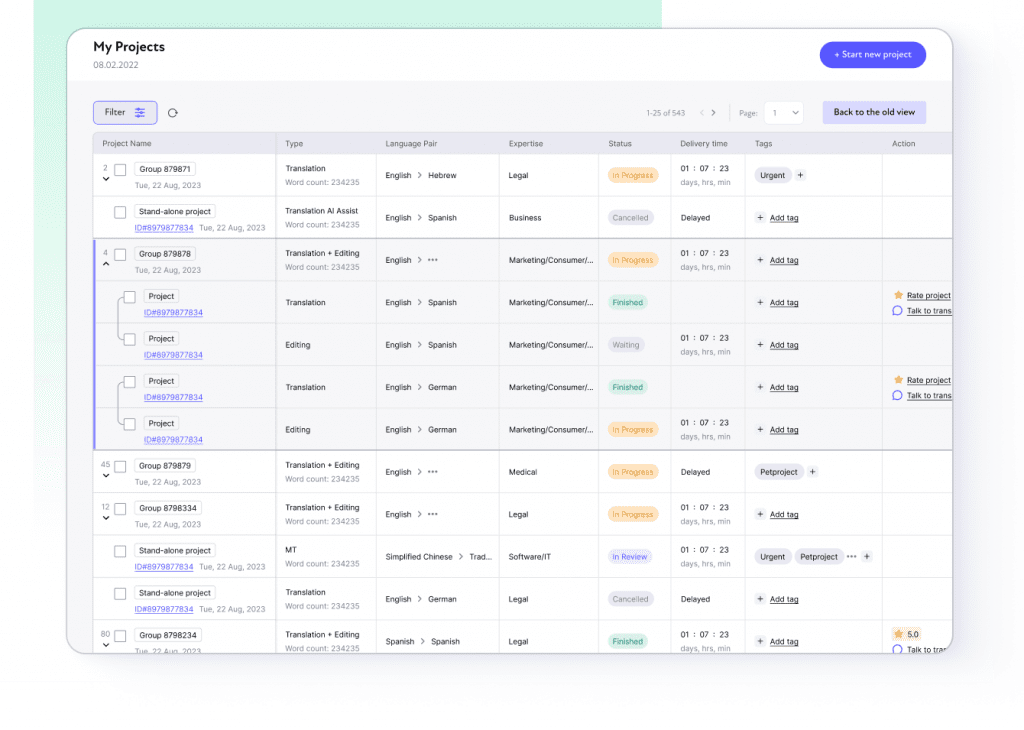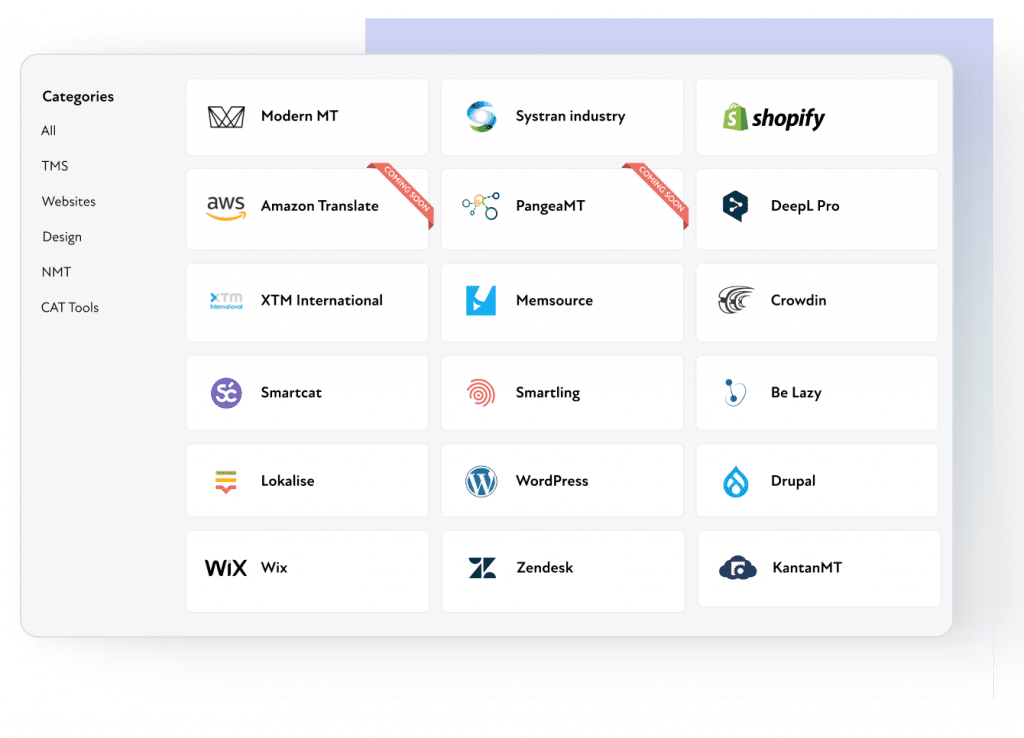Corinne Sharabi
Corinne is the Social Media and Content Lead at BLEND. She is dedicated to keeping global business professionals up to date on all things localization, translation, language and culture.

Looking to broaden your customer base internationally? Before your business becomes the global enterprise of your dreams, you’ll need to find the right localization software and tools to get you there.
Localization platforms make it easier to adapt your content for global audiences in their native language, so it feels like your products and services were created for them. The best localization and translation management software should significantly streamline workflows for additional time and cost-saving benefits.
We live in a digital age, where globalization has meant that even the smallest business can compete on the world stage. Although most businesses have the potential to succeed in foreign markets, localization is what separates successful brands from the crowd.
Localization allows companies to connect with diverse audiences in a culturally relevant and meaningful way. By tailoring content to the linguistic and cultural nuances of each market, businesses can build trust, enhance user experience, and drive engagement, ultimately leading to greater global success. Below are a few of the biggest benefits of the localization process.
In the past, language barriers would have prevented some companies from expanding into new territories. Today, localization software makes entering untapped markets easier and more manageable, allowing businesses to significantly grow their customer base.
Non-native speakers shouldn’t be treated like an afterthought. Successful localization ensures that content is fully adapted to new languages, resulting in an intuitive experience that feels as though it was designed for the end user. This boosts engagement, drives conversions, and builds brand loyalty.
Customers love to feel valued. When you go out of your way to create content that’s been tailored for them, the results speak for themselves. Building trust with your customers ensures long-term loyalty, which can also result in invaluable referrals that will grow your customer base further. Low-quality localization, though, can actually decrease brand trust by giving customers the impression that the brand is cheap and unprofessional.
Regulatory compliance can prove a minefield when expanding into new markets. The best localization software company should have local experts who can ensure you’re always on the right side of any legal requirements. This not only saves time by avoiding red tape but it also helps you avoid any costly penalties.
When you adapt content for non-native speakers, you increase the likelihood of them making a purchase or choosing you over competitors. User engagement also benefits when you produce content that resonates with an audience. The more engaged users are, the more likely they are to become loyal customers and brand advocates.
Your branding should remain consistent across every market. With localization software, you can ensure the core meaning of your messaging and brand identity remains intact after content has been adapted.
With localization software, you can easily adapt content to adhere to the local cultural norms and values of your target market. This demonstrates a level of sensitivity that will go down well in new territories and avoids any embarrassing misunderstandings.
Looking for the perfect localization platform and tools to help you penetrate new markets? We’ve rounded up some of the best for you to consider.

An all-in-one localization solution, BLEND is the platform of choice for some of the biggest brands on the planet. Combining powerful AI capabilities with a vast network of expert linguists, BLEND allows you to localize everything from text to multimedia content. Designed for enterprises and small businesses alike, the BLEND platform provides you with a complete localization infrastructure.
In-platform messaging allows you to easily connect with translators working on your project, while API integrations let you create a platform solution that’s tailored to you. You can also choose how you’d like to receive completed translations, be it directly to your CMS, help desk, or eCommerce store. With a user-friendly interface and first-rate customer support, BLEND is an easy choice.
This multi-platform solution is a good choice for agile teams, allowing localization of multiple assets from a centralized platform. Multi-language support, terminology management, and version control capabilities all come as standard here.
Lokalise also impresses with its collaboration tools, making it easier for large teams to stay on track. Workflow management tools are also included. Unfortunately, basic features like some filtering options are missing, while some common file formats aren’t supported.
Although not as well-known as other localization providers, Locize will appeal thanks to its cost-effectiveness and simple design. An intuitive interface makes it a beginner-friendly choice, with plenty of useful features to make adapting content a breeze.
However, there are some key features missing. There’s no machine translation integration. Furthermore, you won’t be able to use an integrated glossary. These absences can really complicate everyday translation tasks, especially when bringing new linguists on board.
Smartling is designed with everyone from translators to senior stakeholders in mind, with a powerful suite of analytics tools that project managers can take full advantage of. A multi-machine translation engine also makes this a serious contender if you’re looking to automate your projects.
The main downside here is that Smartling is relatively complex. It’s an end-to-end software solution, so anyone who plans on using it has a steep learning curve to look forward to.
iLangL Cloud is designed to streamline translation workflows, making it ideal for users with multiple streams of incoming content. Continuous localization capabilities make it ideal if you’re constantly dealing with new content and page updates, while custom integrations mean you readily combine the platform with your translation tools of choice.
That being said, iLangL Cloud may seem a little lightweight if you have experience with other localization solutions. Additionally, some Safari users have reported compatibility issues.
It’s always a good idea to try out a piece of software to see if it fits your requirements before committing to a subscription. However, you can help narrow down your search by checking to see which localization tools are on offer.

The most important aspect of localization software is a translation management system (TMS). With a TMS at your disposal, it’s far easier to manage translation projects. What’s more, centralized management makes it far easier to communicate with teams and enables time-saving automation.
Speaking of automation, many localization software providers now provide it as standard. If you’re looking to roll out large quantities of content within a tight timeframe, AI-enabled automation is a must. As well as streamlining workflows, you’ll be able to unlock the potential of machine-assisted translations.
A computer-assisted translation (CAT) tool is another staple of any good content localization software. CAT tools provide your team with a user-friendly interface that grants context to workflows, making it easier to see how adapted content will look on the page.
Sometimes, translating a word or phrase just doesn’t cut it. In many cases, transcreation is required to capture the core meaning of a phrase, along with writing style and tone of voice. With transcreation tools, you can ensure that your words carry the same emotional weight in every language.
Integration is another hallmark of any good piece of localization software. You’ll need integrations for popular content management systems, your preferred eCommerce platforms, help portals, and more.
Does the software you’re using allow team members to communicate effectively? Everyone from linguists handling the translations to senior stakeholders should be able to communicate, regardless of what time zone they’re in. Software should also be user-friendly with a nominal learning curve to ensure every contributor can utilize the features they need.
Managing a localization project manually is time-consuming and arduous. What’s more, there’s more scope for human error when software is taken out of the equation. With the right localization software, it’s far easier to keep track of everything as you break into new markets.
With localization software, you can dramatically streamline and simplify your workflows. In fact, many workflows can be entirely automated, freeing up precious time for other tasks. The best software also grants you ready access to essential resources like machine translation memory, terminology glossaries, content style guides, and more.
Localization software is also useful for helping contributors visualize site content during the translation process. This helps avoid things like formatting issues, while sentence length can also be adapted when translating from one language into another.
Provided everybody is working on the same platform, there’s also the benefit of real-time communication between project managers and translators. This can dramatically speed up the delivery of translation and localization projects.
There’s a variety of localization software solutions out there, each with their own unique benefits. However, all of them are designed to simplify the translation process and make it easier to adapt content for new audiences.
Translation management systems are the most common type of localization software you’ll encounter. These are essentially digital databases that are used to store and manage content for translation and supporting assets.
Provided a content management system (CMS) offers the right functions, it can be used for localization purposes. A CMS allows users to manage website content as it’s adapted from one language into another, while the best platforms have integrated localization features.
A subtype of the CMS is the so-called global management system (GMS). These are far more advanced and cater to the exacting needs of localization. Premium features allow content to be adapted for cultural differences, while things like global compliance are also taken into account.
Then there are in-house solutions. Otherwise known as on-premises software platforms, these solutions are installed on client servers and are typically used for app and software localization purposes.
Finally, there are a multitude of hybrid localization platforms available. These systems combine the most useful features of different software offerings to provide a platform that’s tailored to the needs of individual clients.
If you want to strike the right chord with customers, you need to speak their language. Localization software can help you do just that, simplifying workflows and streamlining your expansion efforts. Searching for the perfect platform to help you realize your dreams of globalization? It’s time to take a closer look at BLEND.
Offering a one-stop solution for all your localization needs, BLEND offers a centralized platform that lets you (or one of BLEND’s expert project managers) control every aspect of the process. You can manage and monitor projects easily, while there’s plenty of scope for customization. Need more convincing? In addition to powerful AI tools, BLEND boasts a network of more than 25,000 linguists working in more than 120 languages.
Ready to start your journey with BLEND? Get in touch to request a custom demo today.
What our customers are saying